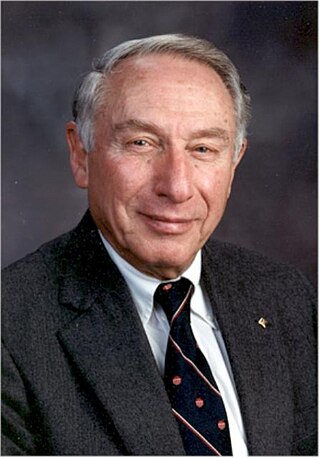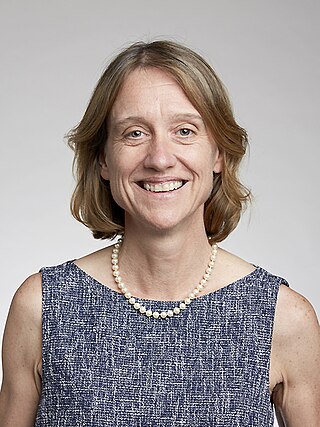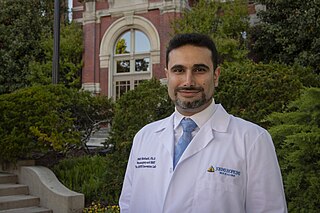
Elastography is any of a class of medical imaging modalities that map the elastic properties and stiffness of soft tissue. The main idea is that whether the tissue is hard or soft will give diagnostic information about the presence or status of disease. For example, cancerous tumours will often be harder than the surrounding tissue, and diseased livers are stiffer than healthy ones.
D. Jackson Coleman is a professor of clinical ophthalmology at NewYork-Presbyterian Hospital at The Edward S. Harkness Eye Institute of Columbia University. He is the former John Milton McLean Professor of Ophthalmology and chairman emeritus at Weill Cornell Medical Center where he served as chairman from 1979 to 2006. His specialties are retinal diseases and ultrasound, working with patients at Columbia University Medical Center. Coleman is also engaged in research involving ultrasound, which he has pursued throughout his career with colleague Ronald Silverman in the Department of Ophthalmology at the Columbia University Medical Center.

Floyd Dunn was an American electrical engineer who made contributions to all aspects of the interaction of ultrasound and biological media. Dunn was a member of Scientific Committee 66 of the National Council on Radiation Protection and Measurements as well as many FDA, NIH, AIUM, and ASA committees. He collaborated with scientists in the UK, Japan, China and Post-Soviet states.
Acoustic radiation force (ARF) is a physical phenomenon resulting from the interaction of an acoustic wave with an obstacle placed along its path. Generally, the force exerted on the obstacle is evaluated by integrating the acoustic radiation pressure over its time-varying surface.

Mathias Fink, born in 1945 in Grenoble, is a French physicist, professor at ESPCI Paris and member of the French Academy of Sciences.
Robert Plonsey was the Pfizer-Pratt University Professor Emeritus of Biomedical Engineering at Duke University. He is noted for his work on bioelectricity.
Ultrasound-modulated optical tomography (UOT), also known as Acousto-Optic Tomography (AOT), is a hybrid imaging modality that combines light and sound; it is a form of tomography involving ultrasound. It is used in imaging of biological soft tissues and has potential applications for early cancer detection. As a hybrid modality which uses both light and sound, UOT provides some of the best features of both: the use of light provides strong contrast and sensitivity ; these two features are derived from the optical component of UOT. The use of ultrasound allows for high resolution, as well as a high imaging depth. However, the difficulty of tackling the two fundamental problems with UOT have caused UOT to evolve relatively slowly; most work in the field is limited to theoretical simulations or phantom / sample studies.
Capacitive micromachined ultrasonic transducers (CMUT) are a relatively new concept in the field of ultrasonic transducers. Most of the commercial ultrasonic transducers today are based on piezoelectricity. In CMUTs, the energy transduction is due to change in capacitance. CMUTs are constructed on silicon using micromachining techniques. A cavity is formed in a silicon substrate, and a thin layer suspended on the top of the cavity serves as a membrane on which a metallized layer acts an electrode, together with the silicon substrate which serves as a bottom electrode.
The IEEE Biomedical Engineering Award is a Technical Field Award of the IEEE given annually for outstanding contributions to the field of biomedical engineering. It was established in 2010.
Piezoelectric micromachined ultrasonic transducers (PMUT) are MEMS-based piezoelectric ultrasonic transducers. Unlike bulk piezoelectric transducers which use the thickness-mode motion of a plate of piezoelectric ceramic such as PZT or single-crystal PMN-PT, PMUT are based on the flexural motion of a thin membrane coupled with a thin piezoelectric film, such as PVDF.
Craig Shelby Henriquez was an American biomedical engineer, Professor of Biomedical Engineering and Computer Science at the Duke University, and was the co-founder and co-director of the Center for Neuroengineering. His research interests were in the areas of large-scale computer modeling of the cardiac bidomain and neuroengineering.
Ultrasound computer tomography (USCT), sometimes also Ultrasound computed tomography, Ultrasound computerized tomography or just Ultrasound tomography, is a form of medical ultrasound tomography utilizing ultrasound waves as physical phenomenon for imaging. It is mostly in use for soft tissue medical imaging, especially breast imaging.

Julia Alison Noble is a British engineer. She has been Technikos Professor of Biomedical Engineering at the University of Oxford and a fellow of St Hilda's College since 2011, and Associate Head of the Mathematical, Physical and Life Sciences Division at the university. As of 2017, she is the chief technology officer of Intelligent Ultrasound Limited, an Oxford spin-off in medical imaging that she cofounded. She was director of the Oxford Institute of Biomedical Engineering (IBME) from 2012 to 2016. In 2023 she became the Foreign Secretary of The Royal Society.
Eleanor Phoebe Jane Stride is a Professor of Biomaterials at St Catherine's College, Oxford. Stride engineers drug delivery systems using carefully designed microbubbles and studies how they can be used in diagnostics.

Muyinatu "Bisi" A. Lediju Bell is the John C. Malone Associate Professor of Biomedical Engineering, Electrical and Computer Engineering, and Computer Science at Johns Hopkins University. She is also the director of the Photoacoustic and Ultrasonic Systems Engineering Laboratory.
Kathryn Radabaugh Nightingale is an American biomedical engineer and academic in the field of medical ultrasound. She is the Theo Pilkington Distinguished Professor of Biomedical Engineering at Duke University, and an elected fellow of the American Institute for Medical and Biological Engineering (AIMBE) and the National Academy of Inventors (NAI).
James (Jim) Gegan Miller is an American physicist, engineer, and inventor whose primary interests center around biomedical physics. He is currently a professor of physics, Medicine, and Biomedical Engineering, emeritus, at Washington University in St. Louis, where he holds the Albert Gordon Hill Endowed Chair in the Faculty of Arts and Sciences. He is notable for his interdisciplinary contributions to biomedical physics, echocardiography, and ultrasonics.

Katherine Whittaker Ferrara is an American engineer who is a professor of radiology at Stanford University. Ferrara has been elected a Fellow of the American Association for the Advancement of Science, Institute of Electrical and Electronics Engineers and American Institute for Medical and Biological Engineering.
Melissa Louise Mather is an Australian physicist who is Professor in Biological Sensing and Imaging at the University of Nottingham. Her research considers the development of novel sensing techniques, including ultrasound, single molecule imaging and nitrogen-vacancy centers in diamond.

Amir Manbachi is an Iranian-born, Canadian-American academic and researcher, currently working as an Associate Professor of Neurosurgery and Biomedical Engineering at Johns Hopkins School of Medicine, and known for his work in Medical Ultrasound. He is the co-founder and current director of HEPIUS Innovation Lab at Johns Hopkins University.
 Wikidata ()
Wikidata () Wikidata ()
Wikidata () Wikidata ()
Wikidata () Wikidata ()
Wikidata () Wikidata ()
Wikidata ()





